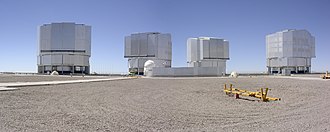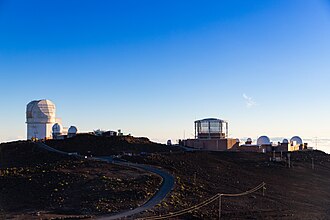Observatory

An observatory is a location used for observing terrestrial, marine, or celestial events.
Astronomical observatories
Astronomical observatories are mainly divided into four categories:
Ground-based observatories
Ground-based observatories, located on the surface of Earth, are used to make observations in the radio and visible light portions of the electromagnetic spectrum. Most optical telescopes are housed within a dome or similar structure, to protect the delicate instruments from the elements. Telescope domes have a slit or other opening in the roof that can be opened during observing, and closed when the telescope is not in use. In most cases, the entire upper portion of the telescope dome can be rotated to allow the instrument to observe different sections of the night sky. Radio telescopes usually do not have domes.[citation needed]
For optical telescopes, most ground-based observatories are located far from major centers of population, to avoid the effects of
Specific research study performed in 2009 shows that the best possible location for ground-based observatory on Earth is Ridge A — a place in the central part of Eastern Antarctica.[4] This location provides the least atmospheric disturbances and best visibility.[citation needed]
Radio observatories
Beginning in 1933,
Highest astronomical observatories
Since the mid-20th century, a number of astronomical observatories have been constructed at very
Oldest astronomical observatories
The oldest proto-observatories, in the sense of an observation post for astronomy,[14]
- Wurdi Youang, Australia
- Zorats Karer, Karahunj, Armenia
- Loughcrew, Ireland
- Newgrange, Ireland
- Stonehenge, Great Britain
- Chankillo, Peru
- El Caracol, Mexico
- Abu Simbel, Egypt
- Kokino, Kumanovo, North Macedonia
- Observatory at Rhodes, Greece[15]
- Goseck circle, Germany
- Ujjain, India
- Arkaim, Russia
- Cheomseongdae, South Korea
- Angkor Wat, Cambodia
The oldest true observatories, in the sense of a specialized research institute,[14][16][17] include:
- 825: Al-Shammisiyyah Observatory, Baghdad, Iraq
- 869: Mahodayapuram Observatory, Kerala, India
- 1259: Maragheh Observatory, Azerbaijan, Iran
- 1276: Gaocheng Astronomical Observatory, China
- 1420: Ulugh Beg Observatory, Samarqand, Uzbekistan
- 1442: Beijing Ancient Observatory, China
- 1577: Constantinople Observatory of Taqi ad-Din, Turkey
- 1580: Uraniborg, Denmark
- 1581: Stjerneborg, Denmark
- 1633: Leiden Observatory, Netherlands
- 1642: Panzano Observatory, Italy
- 1642: Round Tower, Denmark
- 1667: Paris Observatory, France
- 1675: Royal Greenwich Observatory, England
- 1695: Sukharev Tower, Russia
- 1711: Berlin Observatory, Germany
- 1724: Jantar Mantar, India
- 1753: Stockholm Observatory, Sweden
- 1753: Vilnius University Observatory, Lithuania
- 1753: Real Instituto y Observatorio de la Armada, Spain[18]
- 1759: Trieste Observatory, Italy.
- 1757: Macfarlane Observatory, Scotland.
- 1759: Turin Observatory, Italy.
- 1764: Brera Astronomical Observatory, Italy.
- 1765: Mohr Observatory, Indonesia.
- 1771: Lviv Observatory, Ukraine.
- 1774: Observatory of the Vatican, Italy.
- 1785: Dunsink Observatory, Ireland.
- 1786: Madras Observatory, India.
- 1789: Armagh Observatory, Northern Ireland.
- 1790: Royal Observatory of Madrid, Spain,[19]
- 1803: National Astronomical Observatory, Bogotá, Colombia.[20]
- 1811: Tartu Old Observatory, Estonia[21]
- 1812: Astronomical Observatory of Capodimonte, Naples, Italy
- 1830/1842: Depot of Charts & Instruments/US Naval Observatory,[22][23] US
- 1830: Yale University Observatory Atheneum, US
- 1834: Helsinki University Observatory, Finland[24]
- 1838: Hopkins Observatory, Williams College, US
- 1838: Loomis Observatory, Western Reserve Academy, US
- 1839: Pulkovo Observatory, Russia
- 1842: Cincinnati Observatory, US
- 1844: Georgetown University Astronomical Observatory, US
- 1847: Harvard College Observatory, US
- 1854: Detroit Observatory, US
- 1873: Quito Astronomical Observatory, Ecuador
- 1878: Lisbon Astronomical Observatory, Portugal
- 1884: McCormick Observatory, US
- 1888: Lick Observatory, US
- 1890: Smithsonian Astrophysical Observatory, US
- 1894: Lowell Observatory, US
- 1895: Theodor Jacobsen Observatory, US
- 1897: Yerkes Observatory, US
- 1899: Kodaikanal Solar Observatory, India
Space-based observatories

Space-based observatories are telescopes or other instruments that are located in
Airborne observatories

Airborne observatories have the advantage of height over ground installations, putting them above most of the Earth's atmosphere. They also have an advantage over space telescopes: The instruments can be deployed, repaired and updated much more quickly and inexpensively. The Kuiper Airborne Observatory and the Stratospheric Observatory for Infrared Astronomy use airplanes to observe in the infrared, which is absorbed by water vapor in the atmosphere. High-altitude balloons for X-ray astronomy have been used in a variety of countries.[citation needed]
Volcano observatories
A
See also
- Equatorial room
- Fundamental station
- Ground station
- List of astronomical observatories
- List of observatory codes
- List of telescope parts and construction
- Observatory Street, Oxford, England
- Science tourism
- Space telescope
- Telescope
- Timeline of telescopes, observatories, and observing technology
- Weather observatory for weather forecasting
- Research station
References
- ^ "ALMA's Solitude". Picture of the Week. ESO. Retrieved 26 December 2012.
- ^ Chaisson, Eric; McMillan, Steve (2002). Astronomy Today, Fourth Edition. Prentice Hall. pp. 116–119.
- ^ Chaisson, Eric; McMillan, Steve (2002). Astronomy Today, Fourth Edition. Prentice Hall. p. 119.
- S2CID 11166739.
- .
- ^ Yoshii, Yuzuru; et al. (August 11, 2009). "The 1m telescope at the Atacama Observatory has Started Scientific Operation, detecting the Hydrogen Emission Line from the Galactic Center in the Infrared Light". Press Release. School of Science, the University of Tokyo. Archived from the original on 28 May 2010. Retrieved 21 December 2009.
- ^ Taavi Tuvikene, Tartu Old Observatory, 18 February 2009
- ^ Tartu Observatory – Official website (English version)
- ^ Official Web Site of the Sydney Observatory
- ^ "One of the Oldest Observatories in South America is the Quito Astronomical Observatory". Archived from the original on 2012-01-18. Retrieved 2015-01-05.
- ^ Official website of the Quito Astronomical Observatory
- ^ "Slovakia's High Tatras mountains are seen from the solar observatory station on the Lomnicky Stit peak". BBC. 5 September 2014.
- ^ A long time exposed picture taken by night shows Slovakia's High Tatras mountains seen from the Solar observatory station on the Lomnicky Stit peak Archived 2017-10-16 at the Wayback Machine 4 September 2014.
- ^ ISBN 978-0-415-12410-2.
- ^ "Facts about Hipparchus: astronomical observatory, as discussed in astronomical observatory:". Encyclopædia Britannica.[dead link]
- ISBN 0-567-08969-X
- doi:10.1086/349558.
- ^ "Royal Institute and Observatory of the San Fernando Armada". Archived from the original on 2012-03-08. Retrieved 2013-09-13.
- ^ "Real Observatorio de Madrid - Breve semblanza histórica". Archived from the original on 2013-07-26.
- ^ "Observatorio Astronómico Nacional (Universidad Nacional de Colombia)". Archived from the original on 2008-05-11. Retrieved 2019-08-24.
- ^ "On its 200th Anniversary Tartu Old Observatory Opens Doors as a Museum". Visit Estonia. 26 April 2011. Archived from the original on 29 April 2011. Retrieved 26 January 2013.
- ^ "Astronomy and Astrophysics (United States Naval Observatory)". Heritage Preservation Services, National Park Service. 2001-11-05. Archived from the original on 2011-06-29. Retrieved 2011-11-03.
- S2CID 25585014– via Zenodo.
- ^ History of astronomy at University of Helsinki 1834–1984 (in Finnish)
- ^ Chaisson, Eric; McMillan, Steve (2002). Astronomy Today, Fourth Edition. Prentice Hall.
- ^ "A Brief History of the Hubble Space Telescope: Why a Space Telescope?". NASA. Retrieved 2006-08-14.
- ^ "USGS operates five U.S. Volcano Observatories". U.S. Geological Survey. Retrieved 8 February 2021.
Further reading
- Aubin, David; Charlotte Bigg, and Czar Nicholas I, and physics and the astronomical community in late 19th-century America.
- Brunier, Serge, et al. Great Observatories of the World (2005)
- Dick, Steven. Sky and Ocean Joined: The U.S. Naval Observatory 1830–2000 (2003)
- Gressot Julien and Jeanneret Romain, « Determining the right time, or the establishment of a culture of astronomical precision at Neuchâtel Observatory in the mid-19th century », Journal for the History of Astronomy, 53(1), 2022, 27–48, https://doi.org/10.1177/00218286211068572
- Leverington, David. Observatories and Telescopes of Modern Times - Ground-Based Optical and Radio Astronomy Facilities since 1945. Cambridge University Press, Cambridge 2016, ISBN 9780521899932.
- McCray, W. Patrick. Giant Telescopes: Astronomical Ambition and the Promise of Technology (2004); focuses on the Gemini Observatory.
- Sage, Leslie, and Gail Aschenbrenner. A Visitor's Guide to the Kitt Peak Observatories (2004)
External links
- Western Visayas Local Urban Observatory (archived 19 September 2008)
- Dearborn Observatory Records, Northwestern University Archives, Evanston, Illinois (archived 4 September 2015)
- Coordinates and satellite images of astronomical observatories on Earth
- Milkyweb Astronomical Observatory Guide world's largest database of astronomical observatories since 2000 – about 2000 entries
- List of amateur and professional observatories in North America with custom weather forecasts
- Map showing many of the Astronomical Observatories around the world (with drilldown links)
- Mt. Wilson Observatory




